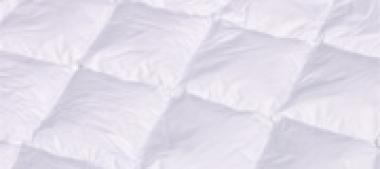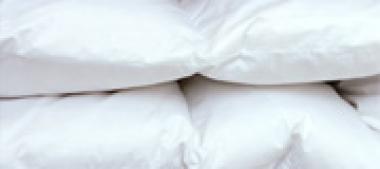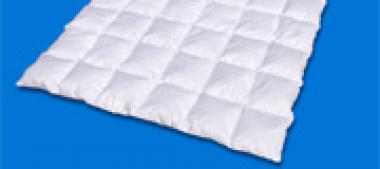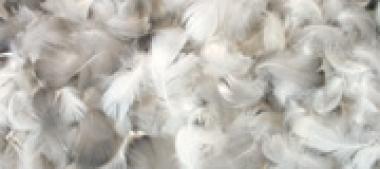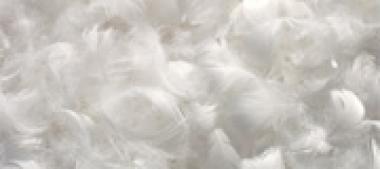Purchasing recommendations

Purchasing recommendations
 Recently visited pages
Recently visited pages
No, tall people must not get cold feet either. Duvets are available in many requested sizes. Ask specifically for different sizes when buying a duvet.

Is it true that heat is likely to accumulate under featherbeds?
Down-and-feather-filled duvets are always capable to regulate the climate in bed. The idea of heat accumulation under a down–and-feather-filled duvet might trace back to the “bulging balloon bed” shown on the pictures in Wilhelm Busch´s classic children´s stories. However, scientific research on the subject “micro climate in bed“ revealed that high temperatures do not occur under featherbeds, even less under a down-filled duvet which is light by nature.
Further information at :
Duvets sewn in diamond patterns or square boxes etc. – what are the differences ?
The type of duvet is crucially determined by the kind of stitching. A duvet is stitched-through in a certain manner to make the filling stay in place and permanently fix it.
Also, the way of stitching has an impact on the degree of thermal insulation. For instance, summer duvets are sewn fabric-to-fabric, intended to create cold zones. Winter duvets containing larger amounts of down and feathers are provided with interior baffle walls stitched between the upper and the lower sides of the fabric layers to impede the formation of such cold zones.
Both types of duvets are available in a number of different make-ups and appearances.
Only the traditional “bag duvet” is not stitched at all.
Only the traditional “bag duvet” is not stitched at all.
- Bag duvet: The so-called bag duvet consists just of the filling and the fabric shell without any special construction. It is not stitched-through at all and does not have any compartments. So the filling is not evenly spread over the area of the duvet. The traditional bag duvet is still available in the market though it has become less important in comparison with stitched-through duvets.
Initially, a small continental bag duvet was called “plumeau“ (size about 130 x 130 cm). Sometimes the term is also used for the traditional larger bag duvets without any compartments or stitched-through patterns.
- Duvet with diamond pattern: Small discontinuous baffle walls stitched alternately in crosswise and lengthwise ensure that the filling is fixed.
The capability of the down / feather filling to move inside the ticking shell is restrained. It is impossible for the filling to get out of place. The filling within the duvet can be spread according to desire. Since the interior baffle walls do not form enclosed compartments, they must no be filled one by one.
- Stitched-through duvet sewn in diamond pattern: The shell of the duvet is sewn in numerous small diamond patterns ensuring that the filling is permanently fixed. In this case, the upper and the lower sides of the ticking are sewn on top of one another – i.e. without any baffle walls.
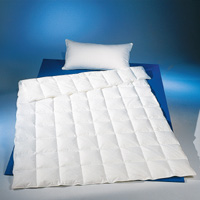 Example of a stitched-through duvet.
Example of a stitched-through duvet.
-
Duvet with interior baffle walls: This type of duvet is provided with continuous baffle walls which are stitched in diamond pattern between the upper and the lower sides of the ticking to make sure that the filling is evenly spread over the area of the duvet and the height is even at all places as requested. So-called cold zones cannot occur.Single compartments are constituted in various numbers. The duvet may for instance be composed of 3 x 4 or 4 x 6 boxes. The filling is divided in single compartments and permanently fixed that way. Each compartment is filled individually.The height of the interior baffle walls may range from to 2 cm to 15 cm in order to obtain the requested degree of thermal insulation (low baffle walls for a summer duvet and high ones for a winter duvet).
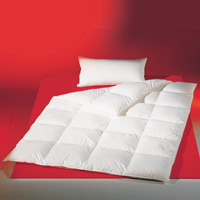
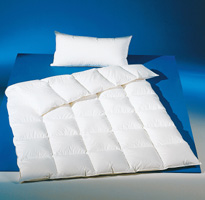

Examples of duvets with interior baffle walls.
- All-seasons duvet: This type of duvet consists of two single duvets with different filling weights: The lighter one is suitable for use in summer and the other duvet offers a higher degree of thermal insulation suitable for spring or autumn. If the two single duvets fit together (for instance with buttons, zip fasteners or tape), a duvet will be created which offers excellent thermal insulation, that is to say a winter duvet.
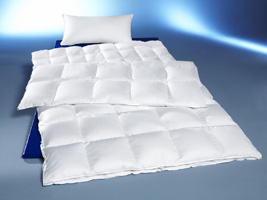 Example of a all-seasons duvet.
Example of a all-seasons duvet.
Down duvet and feather duvet – what are the differences?
As stipulated in the European standard EN 13186, duvets with a down content of at least 60% may be labelled as down duvet. Duvets with a down content below 60% are labelled as feather duvets.

Why do down-and-feather-filled duvets provide such a favourable micro climate?
Bedding products filled with down and feathers are capable of providing a high degree of thermal insulation with a low filling weight. The comparatively low filling weight is a significant factor for sleeping comfort – the duvet is supposed to keep the body warm with very little weight.
Humidity is another important criterion for the climate in bed. Bedding products filled with down and feathers are capable of absorbing and transmitting the body's humidity so that it is not perceived by the sleeper as being uncomfortable. A scientific study confirmed the favourable micro climate created under down-and-feather-filled duvets and clearly showed that there is no heat accumulation under featherbeds.
In the scope of a scientific study conducted by the University of Kiel in 1992, the issue of what impact the duvet has on the micro climate of the bed was investigated in particular.
As part of a major study with test subjects, 14 duvets were investigated, which reflect the supply of bedding products currently available on the market, both with regard to the materials used and to the filling quantity (e.g. fillings made of animal hair, silk, synthetics, down and feathers).
For these studies three groups of candidates, namely persons with mild, medium and strong perspiration, were selected so that the whole spectrum of the requirements of a person for a duvet were able to be covered.
During a test with comparable bedding products, the focus of the study was on whether or not the assertion is true that there is heat accumulation under featherbeds.
Heat accumulation is characterised by an increase in the core temperature of a person, so that the sleeper starts to perspire exorbitantly. The duvet was unable to compensate for the temperature in a suitable manner
The tests conducted with different duvets were able to clearly show, however, that inappropriately high temperatures in the bed hollow do not occur under normal bedroom conditions for any filling material, and therefore, also not for featherbeds.

Why are duvets filled with eiderduck down so expensive?
Especially eiderduck down are of high quality. They come from the species eiderduck that are living as protected birds in the wild on the coasts of the Northern Seas. Eiderduck down must be picked from the abandoned nests after the breeding period.
They provide excellent fill power figures which almost double the fill power values of top-quality goose down. One kilogramme contains about 500 000 single eiderdown but only 300 000 goose down. Eiderduck down are even more delicate and lighter than goose or duck down and have a natural brownish colour. They have scarcity value and are difficult to process, respectively, which leads to stiff prices.
They provide excellent fill power figures which almost double the fill power values of top-quality goose down. One kilogramme contains about 500 000 single eiderdown but only 300 000 goose down. Eiderduck down are even more delicate and lighter than goose or duck down and have a natural brownish colour. They have scarcity value and are difficult to process, respectively, which leads to stiff prices.
Eiderducks mainly live in Iceland, Greenland, Scandinavia and the Northern regions of Canada. They breed in hollows on the ground or on rocks and pad out the nests with down they plucked out from their bodies themselves.
Eiderducks are protected birds since they are a critically endangered bird species and cannot be bred.
Eiderducks are protected birds since they are a critically endangered bird species and cannot be bred.
After the young birds left the nest the eiderdown are collected. Only personnel that was well technically trained, is permitted to climb on the rocks to pick the down from the nests after the breeding period. Thus, there is tight supply, but great demand (Saudi-Arabia, Japan).
Eiderduck down have excellent heat-insulating capacities. The barbules are larger than goose and duck down and have countless ramifications. In spite of their size they are even lighter and more delicate than usual goose or duck down. The barbules of eiderduck down are twinned. Their barbs are frizzed and form prongs at their ends which make the down stick together. If they did not form a cohesive pad, the wind would blow the single down out of the nest.
Eiderduck down have excellent heat-insulating capacities. The barbules are larger than goose and duck down and have countless ramifications. In spite of their size they are even lighter and more delicate than usual goose or duck down. The barbules of eiderduck down are twinned. Their barbs are frizzed and form prongs at their ends which make the down stick together. If they did not form a cohesive pad, the wind would blow the single down out of the nest.
The sticky structure of the eiderduck down makes the processing difficult. Bedding articles filled with eiderdown have to be cleaned and processed manually.
Further information on the internet:
What is the right size of a duvet?
The duvet should at least be 20 cm longer than the body size. If it is shorter, you will not enjoy restful sleep because your feet might get cold.
The width of the duvet should not be too small: The comfort size of 155 x 220 cm for a single duvet will be adequate for most people, but many sizes are available also double size, king size etc. and sizes for babies and juniors.

Which duvet and pillow should I buy?
For restful sleep it is important to select the right duvet. People have different needs with respect to restful sleep. Some have a predisposition to perspire, others feel cold easily. Some might prefer a voluminous duvet, the so- called ballon or bag duvet, and do not want a flat stitched-through duvet. Hence, it is necessary to find the appropriate duvet and / or pillow.
Both duvets and pillows have two basic characteristic properties that should be considered:
- the filling material
Two main types of fillings are available. Natural fillings such as down and feathers, wool fibres (virgin wool, camel hair, cashmere), cotton and wild silk – and synthetic fibres, e. g. micro fibres, chemical fibres such as hollow fibres and cellulosic fibres are on sale.
- the type / shape
Since people using duvets have different individual needs and purposes (summer and winter duvets) duvets have been developed in a wide variety. Some are made with interior baffle walls. Duvets without interior baffle walls are stitched-through. They are available in a number of different make-ups and appearance. They can be sewn in box-squares, channels or a number of different patterns – like ring-stitch, diamond or diagonal patterns, etc. so that everyone can find the duvet that meets the requirements.
What are the advantages of down- and feather-filled duvets?
- „Custom-tailored“
When buying duvets and pillows the individual needs while asleep are decisive criteria. Down-and feather-filled bedding products can be “customised”, i. e. they can be manufactured entirely according to the individual needs of the customer. There is a wide variety of duvet sizes, filling weights and stitching patterns so that the duvet can be specially tailored according to individual needs.
In this regard, the individual need for warmth and the requirements for the duvet comfort play a role (weight, drapeabililty).
For instance, a down-filled duvet for the winter with interior baffle walls is ideal for people who feel cold easily at night or want to sleep at low temperatures in a bedroom with an open window. Stitched-through, light down duvets are recommended for use in summer.
Down offer ideal sleeping comfort. They are lightweight and assure excellent climate regulation. A pleasant warmth quickly spreads during the sleep and the absorbed perspiration is being eliminated.
- low weight
Waterfowl feathers (goose and duck) have high fill power values, which means the capacity to trap large quantities of air (bulking power). The filling power of down is even better.
Down-filled duvets contain down imbedding large quantities of air pockets which act as an insulating layer. The percentage of air reduces the weight of the duvet in proportion to its volume. Hence feather- and in particular down-filled duvets keep the body warm and comfortable during the sleep and are very light at the same time.
- Excellent thermal insulation capacity
The insulating effect of a duvet crucially depends on
- the filling material (for instance down and feathers)
The grade of thermal insulation may differ depending on the filling quality and the proportion of down and feathers. The higher the down percentage the better the fill power values and thus the thermal insulation capacity of the duvet.
For this reason, many consumers prefer in particular duvets filled with a blend of 90 % down and 10 % feathers.
Feather and down blends are mainly used for pillows, since feathers help to support the head resting on the pillow, but more and more people now prefer a pillow with a soft down filling.
- the weight of the filling (indicated in grams)
The weight of a filling (indicated in grams) may differ depending on the individual requirements. Depending on the filling weight, the duvets are manufactured for use in summer or in winter. Duvets are available in a wide variety of stitching patterns and constructions to meet the customers´ very special requirements.
The filling of a single size summer duvet weighs about 200 grams, and the filling of a very warm single size duvet with interior baffle walls with various compartments weighs approximately 800 - 1000 grams (size 135 x 200 cm).
- the stitching construction (for instance with or without interior baffle walls).
Basically, the construction of a duvet is determined by the stitching pattern. Duvets are available in a wide variety, the traditional bag duvet or ballon duvet without any stitching, a duvet with various compartments and interior baffle walls. Summer duvets contain cold zones which have been created on purpose, winter duvets are supposed to have a high insulating factor.
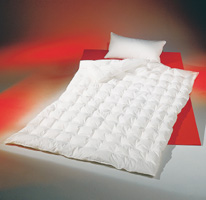 Example of a special stitching. Source: Brinkhaus, Warendorf.
Example of a special stitching. Source: Brinkhaus, Warendorf.
- bulking capacity, that is to say the capacity of the filling to trap air. The air-filled pockets make out the insulating properties of the duvet (fill power). Down provide the best fill power values.
- drapeability
The term “drapeability“ describes the capacity of the duvet to adapt to the shape of the sleeper and his or her movements during the sleep. Since everybody changes the position in bed several times during the sleep, it is crucial that the duvet readily adapts to each position of the body. Channels formed during the sleep admitting cold air to get into the bed might affect restful sleep and are perceived by the sleeper as being uncomfortable.
- Favourable micro climate
Down-and-feather-filled bedding duvets and pillows are very capable of absorbing and transmitting the body's humidity outside the bed even in persons with strong perspiration.
Further information at :
- How does the KIS®-system help to choose the ideal down duvet?
- Why do down-and feather-filled duvets provide such a favourable micro climate?
- What does the term “warmth without weight“ mean?
- What blends of down and feathers are most suitable?
- What are the most useful colours for down and feather blends for pillows?
- What does the term filling weight mean?
- Duvets sewn in diamond patterns or box squares etc. – what are the differences?
- What does the term "fill power" mean?
Things to look for when buying a duvet!
- It must offer ideal heat-insulating capacities to protect the body from cold during the sleep but should not make you feel hot.
- it shall ensure that the perspiration absorbed during the sleep is being eliminated (optimum transport of humidity),
- it shall keep the body warm with as little weight as possible,
- it shall ensure best drapeability and not create cold zones,
- it shall comply with the labelled size. A duvet or pillow should fit into the quilt cover,
- it shall have suitable heat-insulating properties in proportion to its weight (warmth without weight),
- it must have been made properly – this applies for instance to the seams,
- it should be suited for persons suffering from an allergy to house –dust –mites.
Further informatione:
In particular the the brands DOWNPASS, TRAUMPASS and NOMITE help you to find your ideal duvet.
In particular the the brands DOWNPASS, TRAUMPASS and NOMITE help you to find your ideal duvet.






